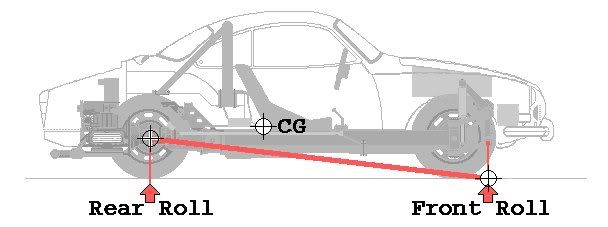FJCamper wrote:Hi Ray,
Yes, before the actual roll centers kick in, we have a lot of pitch and yaw that goes on. This causes weight transfer, and because our VW's have almost no anti-dive or anti-squat in the suspension geometry, handling and stability gets dicey.
On our racing Ghias, I counteract roll, pitch, yaw, and weight transfers as best I can by keeping the suspension firm and the Konis on medium. All I can do is minimize it.
Too hard is asking for trouble and too soft is deadly.
Watts linkages, panhard rods, DeDion rear suspensions, etc., all work but are for different suspensions than our own.
I've mentally designed anti-dive/anti-squat devices, but never built one. I did watch Porsche fight with this problem on our racing team. They kept it simple, only once going to an exotic adjustable rear sway bar controlled by the driver in the 935's.
VW/Porsche handling? If it were easy, anybody could do it.
FJC
Not really. this is where people get too hung up in one system type or another. Suspension systems are themselves collections of methods of tampering with physics. Only a few get named after someone who invented the first one. The components that conrol differnt physical movements get chopped up and grouped together all over the place in differen tsystems.
Are you aware that Watts linkages are used on a great many independent rear ends in cars made as late as this year?
A for instance of an other type: The motion and camber problem of a solid rear beam like the saab had...is nearly identical (though not as extreme) as the swing axle beetle. On the solid beam (like the saab)....when one wheel is depressed...the other lifts pivoting about its center...and increasing camber. They fought this by installing trailing arms at each end as well to make it a solid beam with an extra link at each end. It combats jacking much like going to IRS from swing axle did.
But...because its not perfect....hit a heavy bump that bottoms the trailing arm while going through a curve that has the cross beam pivoting...and you get camber jacking...and a change in body roll center.
What the Watts link does....is allow only 1-2* of change in camber of the wheel (when the wheel/arm reaches its limit of compression)......in relation to camber of the body.
So when for whatever reason, either curves, braking etc...the body has an enertial shift change forward...pivoting or rolling about its center....the watts link acts as a leash...and limits not only the forward motion of the body but how much it can lift off of the rear suspension. It controls how far the suspension can unloaded. It limits the pivoting arc of the trailing arms.
The funny thing is that the Saabs like all vehicles now was a motly collection of solid rear beam with pivoting trailing arms and a panhard rod...which was totally rendered unneeded....by installing the watts links.
The watts links were more oft than not seen on A-arm and transverse A-arm suspensions.
Because this watts link is NOT ball jointed (whcih the cheesy diagram did not show)...but is actually a barrel and bushing assembly at each end ....just like a control arm....it also does not allow the body to sway sideways out of alignment with the wheels through cornering.
This type of link is not a product or characteristic of any particular suspension style. It can be readily used on any suspension that incorporates a trailing arm.
It can also be used on both front and rear suspension and has been on many vehicles. In fact...some of the front four link and multilink suspensions are simply derivatives of a watts link.
On a front suspension...a watts links would generally trail from forward. It could also lead from backward on a struts suspension that does not employ a radius or diagonal arm. The exception is that on a front suspension ...a watts link (probablycalled something else when used up front)....does not counter body roll. It counters random directional changes and bump steering by countering compression of control arm and radius arm bushings that come from the friction of forward motion of the tires, striking ridges and bumps.
Most modern multilink suspensions have details from several classic original suspension systems.
Don't get lost in the thought that "Our cars are not using that sort of suspension". Look instead at what characteristic of physical reaction a given suspension component is countering...and decide if that one sub-component could be useful. See how other people solved the problem you are having...and steal/borrow from their effortsRay

